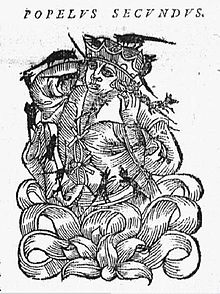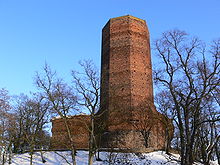Popiel
Popiel II ( Latin: Pompilius II ), reconstructed as Pąpil , was a legendary Polish ruler from the 9th century .
Etymology to "Popiel"
The name Popel was recorded in the “Rocznik małopolski” (Małopolska Yearbook), from which the oldest manuscript comes from the 15th century. The name form Popiel is derived from this name , as Gerard Labuda asserted: "The name form with the letter e was certainly added to the texts later in order to enable the folk etymology of the Polish word popiół , as with Jan Długosz ."
The Cronica et gesta ducum sive principum Polonorum by Gallus Anonymus has two forms of name on the third registration card and in the chapter heading. On the tab appears double bogey , while in the chapter heading of three Pumpil is talk. According to the Polish historian Zofia Kozłowska-Budkowa (1893–1986), this was the handwriting of Wincenty Kadłubek , who consistently used the chronicle at the turn of the 12th to the 13th century. After Kadłubek goes the Chronicon Polonorum , which says filio secum retento, cui nomen Pompilius . The Chronica principum Poloniae (Chronicle of the Polish Princes), which was created a hundred years later and directly used the autograph Gallus Anonymus, also filio suo retento, cui nomen erat Popil vel Pompilius . It sounds exactly the same with Jan Długosz added in latino idiomate vocatus Cinereus, in Almannico: Osszerich . However, Długosz uses both forms of the name: Pompilius ... sive Popyel .
Against this background, the Polish etymologist Andrzej Bańkowski (1931-2014) held the name Pumpil for the original form, while Gerard Labuda thought the Pompil form with the “ prosthesis ” of the nasal vowel was the original and Pumpil was a modification. But he basically agreed that the name contained a nasal sound, such as B. with uzasφpy = "w zastępy", pφte = "piąte", in other scripts ø (so-called "o rogatego") z. B. at prawdø to "prawdę", nademnø to "nade mną", but mostly with the help of the "prosthesis" to a similar sounding, z. B. Wenczeslaus (1393) to Więcesław or Zambrowo (1425) to Zambrów , from the proper name ząbr present and hyper-correct through Mazurzenie to żubr and had the wording Pąpyl . Andrzej Bańkowski goes on and derives this personal name etymologically from Pąpyl (further variants Pąpil, Pąpiel), which in Polish has now become "bąbel" (bubble). In his opinion, this could be an allegory for "governments without recognition". Pąpyl in the sense of "bąbel na skórze" (blister on the skin) appeared in the 15th century in the gloss Żywot św. Jadwigi on, secondary pąpel, pępel in 1578 and 1596 in the plural form pępele .
Popiel among the early chroniclers of Poland
Gallus Anonymous
"... It was in Gniezno , [...] Duke Popiel, who had two sons ..."
With this quote, the Chronicle mentions a Popiel for the first time; she calls it a dux in civitate gneznensi . During the head shearing of his sons (old Slavic initiation ritual), two mysterious guests are said to have arrived in Gniezno, but they were not invited to the feast and broke the principle of hospitality. So you were visiting poor Rademacher Piast , who also shaved his son Siemowit's head . According to Gallus, Popiel must also have been present during this headshear, because the Duke himself did not even think of the impairment of letting his farmers get that far . When Siemowit was grown, he tried to overthrow Popiel to become a duke. Gallus complements their historical relationship and portrays Popiel as a tyrant who neglected the defense of the Polans against the invading Vikings and who murdered his relatives at the insistence of his wife, whom he had accused of conspiring against him. He was then deposed by Piast and holed up on the tower of Kruszwica on Lake Goplo . There, like his wife, he was eaten by mice.
A similar legend has to do with the Mainz bishops Hatto I and Hatto II , who are said to have been eaten by mice in the Bingen mouse tower in the 10th century because of their hard-heartedness .
Wincenty Kadłubek
Wincenty Kadłubek's Polish Chronicle extends the important legend to Popiel (called Pompiliusz II) and makes him son Popiel I and grandson Leszko III. According to Kadłubek, he was a man with a very feminine character, indolent, cowardly and insidious. At the insistence of his wife, he is said to have poisoned the wine of his guests during a large feast and thus to have his twelve uncles on his father's side (sons Leszko III) on the conscience. With the corpses came the mice, which Popiel, his wife and his two sons long chased. Finally the mice grabbed her in a tall tower.
Wielkopolska Chronicle
The Wielkopolska Chronicle after got Popiel because of his long hair nicknamed Chościsko that as much as, Broom "is (according to Gallus Anonymus was the nickname the Prince Piast). The Wielkopolska Chronicle also names the Mouse Tower of Kruszwica as the place where Popiel died. This is also repeated in the Polish-Silesian Chronicle and the Chronicle of the Polish Princes . The Kruszwica mouse tower that exists today was only built by Kazimierz Wielki in 1350 .
Later chroniclers
According to the Slavic Chronicles of the Kingdom of Poland (yearbooks), Chościsko was a contemptuous nickname of Popiel, which means ' wasting , dilapidated broom'.
The following storylines for the legend of Popiel and the Mice were added by the chronicler Jan Długosz . According to him, Popiel's demonic wife Gerda was a German princely daughter and his sons were named Lech and Popiel. The chronicler also compared the ruler with the Roman Emperor of the German nation Arnulf von Kärnten , who resided in Regensburg from 896–899.
The chronicler Marcin Bielski places Popiel much earlier in the time of Louis the Pious .
Hypotheses
As the Polish historian Prof. Jacek Banaszkiewicz (* 1947) proved, the statements by Gallus Anonymus about the legend about his death by the mice - contrary to popular theory - are not to be taken literally. They are borrowed from the German “ mouse legends”, especially from the one in the Binger Mäuseturm . This makes it an Indo-European element of a purely symbolic heritage.
The Polish historian Dr. Henryk Łowmiański (1898–1984), on the other hand, put forward the hypothesis that the legendary Popiel was the ruler of the West Slavic Goplanen tribe in the 9th century , the last of the pre- Piast dynasty, the so-called Popielids , and that his overthrow by Siemowit was the Liberation of the Polans from the all-dominating goplanes. He identified the island on which Popiel had to die at Ostrów Lednicki . According to the historian, “the mice” meant the people who revolted at the time, possibly from the small, Greater Poland village of Myszki (Mice), which today belongs to Gmina Kiszkowo in the Powiat Gnieźnieński .
The historical popiel
Those who assume the historicity of the three living predecessors Mieszko I - Siemowit , Lestek and Siemomysław - usually also assume the historicity of Popiel. However, new archaeological finds pose problems. They prove that Popiel could not have resided in a castle in Gniezno, because the castle in Gniezno was only built around the year 940, so that Popiel's reign probably falls into the second half of the 9th century. Archeology therefore currently attributes the castle in Giecz to Popiel as the headquarters. So it could be that Popiel ruled over the Gniezno region in a tribal castle unknown to us by the name, although he was ideologically connected to the cultural center on the Lech hill (Gniezno) , which is why Gallus Anonymus was not so familiar with the details of the Tradition and Popiel describes as the Duke of Poland residing in Gniezno. As archeology shows, at the time of Popiel and Siemowit, the royal rulers did not yet have a great deal of economic and military knowledge that would have made it possible for the population to build state castles under the supervision of military troops. The rule of Popiel and Siemowit was unstable (leadership organization after P. Urbańczyk) and was thus largely controlled. Popiel likely failed to perform his duties of redistributing surplus production between members of his community of property, and as a result, he was replaced by successful lobbying policies by Siemowit.
Popiel in literature
Popiel is one of the key characters in Stara baśń , a historical novel by Józef Ignacy Kraszewski . There he is a cruel ruler, active but above all under the great influence of his German wife Brunhilde.
When Roman Dagome iudex of Zbigniew Nienacki Popiel in the first volume is Yes, Dago presented as Golub Popiołowłosy. Then he was imprisoned by his wife Helgunde in the tower on an island. The hero Dago released him and allowed him to emigrate, but when asked by the servants about Popiel's fate, he replied: People say ... that Popiel was eaten by the mice.
The figure of Popiel, viewed through the cultural glasses of Filozofia genezyjska , is the Rhapsody I Król-Duch by Juliusz Słowacki .
literature
- Jacek Banaszkiewicz: Podanie o Piaście i Popielu , Warszawa, 1986
- Andrzej Biernacki: Z dziejów podania o Popielu [From the history of the Popiel legend], in: Literature ludowa. Kujawy [folk literature. Kuyavia]. Vol. 1, Warszawa 1963 (Polskie Towarzystwo Ludoznawcze. VII. 2-3), pp. 57-67; ders., Popiel, in: Słownik folkloru polskiego [Dictionary of Polish Folk Literature], ed. by Julian Krzyżanowski , Warszawa 1965, p. 324ff.
- Henryk Łowmiański, Dynastia Piastów we wczesnym średniowieczu , in: Początki Państwa Polskiego, Vol. 1, Poznań, 1962
- Henryk Łowmiański: Początki Polski , Vol. 5, Warszawa, 1973
- Józef Maksymilian Ossoliński: Vincent Kadłubeck . E. Historical-critical contribution to Slavic literature, translated from Polish into German by Samuel Bogumił Linde, Warszawa, 1822, p. 233ff., Also online
- Richard Röpell: The historical saga of the Poles , in: "Geschichte Polens", vol. 1, Hamburg 1840, p. 51ff., Also online
- Jerzy Strzelczyk: Mity, podania i wierzenia dawnych Słowian , Poznań: Rebis, 2007. ISBN 978-83-7301-973-7 .
- Jerzy Strzelczyk: Od Prasłowian do Polaków , Kraków: Krajowa Agencja Wydawnicza, 1987. ISBN 83-03-02015-3 .
- Stanisław Trawkowski: Jak powstawała Polska , Warszawa, 1969.
Individual evidence
- ↑ Chronica principum Poloniae [w:] Scriptores rerum Silesiacarum , Wrocław (Breslau) 1835, p. 38, (Latin), footnotes: (German)
- ↑ Kazimierz Rymut : Nazwy miast Polski , Wrocław 1980, p.274
- ↑ Gerard Labuda: O najstarszych imionach dynastii piastowskiej [w:] Biedni i bogaci. Studia z dziejów społeczeństwa i kultury ofiarowane Bronisławowi Geremkowi w sześćdziesiątą rocznicę urodzin, Warszawa 1992, pp. 261-274
- ↑ Aleksandra Cieślikowa, Janina Szymowa, Kazimierz Rymut: Słownik etymologiczno-motywacyjny staropolskich nazw osobowych . Część 1: odapelatywne nazwy osobowe, Kraków 2000, p. 230
- ^ Gallus Anonymus , Kronika polska , Zakład Narodowy Ossolińskich, Wrocław 2003, ISBN 978-3-939991-64-9 , p. 11
- ^ Gallus Anonymus: Kronika polska . Wrocław: Ossolineum / DeAgostini, 2003, s. 13, seria: Skarby Biblioteki Narodowej. ISBN 83-7316-258-5
- ↑ Pittacus Franciscanus, 1652: wife of the legendary Popiel
| predecessor | Office | successor |
|---|---|---|
| - |
Prince of the Polans approx. 810 - approx. 840 |
Piast |
| personal data | |
|---|---|
| SURNAME | Popiel |
| BRIEF DESCRIPTION | Duke of Poland |
| DATE OF BIRTH | before 810 |
| DATE OF DEATH | after 840 |


